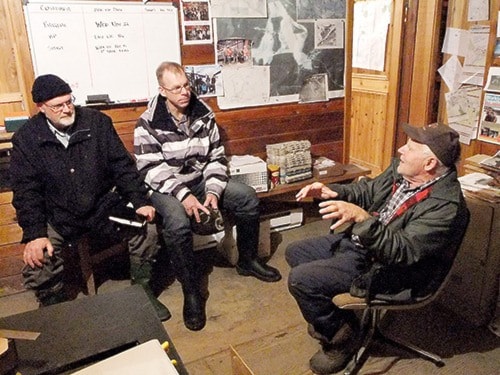A new provincial partnership called Bridges II could mean big opportunities for local woodlot licensees and community forests.
That was the message that consultant Chris Ortner and Jim Burck, community economic development director with the Ministry of Jobs, Tourism and Skills Training, brought to Clearwater on Thursday.
The pair were on a fact-finding tour of the McBride to Barriere corridor. The provincial government has identified the corridor as one of several sub-regional targets for economic development in B.C.
 “The goal is collaboration. We want to leverage the entrepreneurial spirit of the forest industry,” Ortner said. He was speaking at a meeting of woodlot owners and representatives of Wells Gray Community Forest on Thursday evening in the Community Resource Center in Clearwater.
“The goal is collaboration. We want to leverage the entrepreneurial spirit of the forest industry,” Ortner said. He was speaking at a meeting of woodlot owners and representatives of Wells Gray Community Forest on Thursday evening in the Community Resource Center in Clearwater.
Ortner is the former director of operations with Forest Renewal BC.
The consultant predicted the provincial government will expand the community forest and woodlot programs and said local operators should be ready for when that happens.
Possible sources of volume could be under-used species such as birch, or waste wood.
“It’s important that people realize that, while this is a government program, we’re not coming in and telling you what is the model you should follow,” said Burck. “What we do will be based on what works for you. Do you want help with marketing or researching underutilized fibre? We rely on you for ideas you want help on.”
telling you what is the model you should follow,” said Burck. “What we do will be based on what works for you. Do you want help with marketing or researching underutilized fibre? We rely on you for ideas you want help on.”
This is a good area for growing birch, said Brett Colborne, whose family operates a birch sawmill in Upper Clearwater.
“There’s lots of birch, but people aren’t cutting it,” he said.
While they have bought some birch from local woodlots, most of their volume recently has come from Prince George.
“Birch is a tough market,” Colborne said. “We’ve had ups and downs. Last year was our best ever, then we had a three month shutdown. We’re back up now but it’s still not good ... just a small volume.”
Japan is their biggest market, said the Upper Clearwater sawmill operator, but they’ve seen a falling off there as younger people buy printed paper rather than real wood veneers.
Woodlot owner Dave Flear said there were 5,000 piles of logging waste burned in the Valley this fall.
Chris Ortner noted that biggest available under-utilized wood volume is in waste.
Domtar is selling electricity to BC Hydro for 11 cents per kilowatt-hour, plus getting heat that could be used for schools or hospitals.
Seppi Wadlegger said his company has done some research into co-generation plants that are common in Austria and elsewhere in Europe.
Warren MacLennan noted that Kinder Morgan will probably be twinning its Transmountain pipeline within the next few years. When they do, they will dig a trench that would ideal for distributing heat via hot water through the middle of much of Clearwater. MacLennan said he has found Kinder Morgan easy to work with and speculated the pipeline company might be interested in working together on such a project.
One of the woodlot owners present said he has been selling Douglas fir tops under eight inches as pulp.
“That’s not a pulp log,” said Ortner. “That’s a small saw log that doesn’t have a market.”
MacLennan said he has had good success cutting and selling firewood, although it is a lot of work. He gets $500 per cord in Calgary. A truck costs $2,000 and carries 30 cords.
The Bridges 11 program is focussing on two sub-regions in the mountain pine beetle epidemic zone: the McBride to Barriere corridor, and the region around Kaslo.
According to a Bridges II project summary, the corridor between McBride and Barriere has five community forests and over 25 woodlots with a combined AAC (annual allowable cut) of 197,443 cubic meters
The $200,000 funding for the project is coming from a variety of agencies, including the Southern Interior Beetle Action Coalition (SIBAC).
The first phase of the Bridges project was successful in consulting with representatives of small tenure holders and value-added sectors, identifying impediments to increase business activity, and the successful creation and launch of the WoodSourceBC.com website.
Ortner and Burck said they plan to return to Clearwater for a Healthy Forests/Healthy Communities forum scheduled for Jan. 9.
